Quite diaper free (7 topics related to diaper free)
For the international diaper-free week, Janina Pohle from Leonina frei & geborgen has thought about various topics that have something to do with diaper-free. This week there is a lot of input, as well as some discount promotions and contests from manufacturers, stores and coaches. In the course of the diaper-free week, I also thought about the connections between the different topics and diaper-free. I would like to present these to you in the following.
Get to know the diaper-free method in my online course
I have written an online course about diaperfree. You can register for this course on my website, receive access data to the learning portal and can learn the diaper-free method according to your schedule. You can find more information at my online course Diaperfree.
Together with Janina, the diaper-free week was organized by Katharina Nießing from Pace Yourself - Parents Life Balance.
Table of contents
Diaper Free & Baby Massage
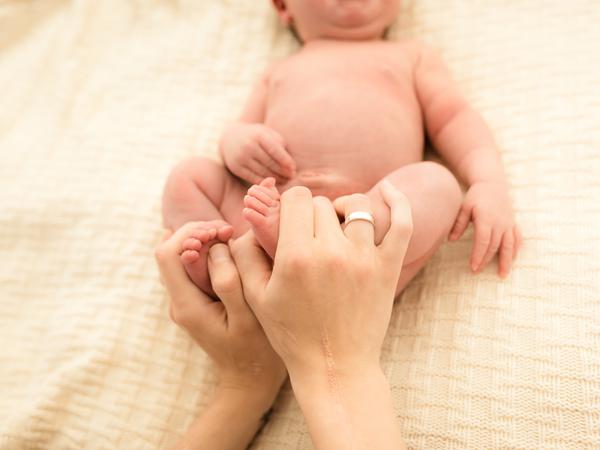
Diaper-free and baby massage? How do they fit together, where are the connections and similarities? This is exactly what we want to talk about here.
Baby massage is a wonderful way to get in touch with your baby. Through the touch and the following reactions of your baby you get to know him. It is an opportunity for exchange and (physical) connection.
With the diaper-free method, you also get to know your baby and enter into an exchange with him.
In both, the exchange takes place mainly through the physical level, less through real sounds, let alone real words. We learn to engage with each other and read our baby's body signals. How often do I hear, "If only I knew what my baby was trying to tell me?" Sure, babies can't yet speak in the classical sense, but they do speak through their bodies.
In order to get to know a baby's excretory signals, it's a good idea to spend some time naked so that you, as mom or dad, can pay even more specific attention to them and also notice excretions directly. Targeted tightening of the abdomen, changes in the genitals, tightening of the legs or restlessness can be noticed more quickly or better assigned.
Also when massaging, you get a direct feedback from the touches about the muscle tension, about well-being or discomfort. Your baby shows you what it likes and what it doesn't. This can also change from time to time over the course of time. If your baby can already turn, he may prefer to have his back massaged than his belly.
It is the same with diaper-free. Just when you think that you have understood everything about your baby and that you are a great team, something can change, so that your baby now perhaps prefers a different holding position or the excretion rhythm changes.
Are you afraid your baby will pee on you during the massage? If your baby is used to you reacting to his elimination signals, he will also show when he needs to be massaged so that you can stop him in time. Naked it is also even easier to recognize the signals.
Baby massage and diaper-free are great ways to get into intimate and deep contact with your baby. It creates a strong bond between you and your baby - without any pressure or stress. Both involve communication that is not (only) expressed on a verbal level.
However, the two areas also have other things in common. Both can be a natural support and help for colic, abdominal pain or constipation. Through a special abdominal massage, the movements of the intestines can be specifically supported. The same applies to the squat holding position. Diaper-free babies also experience significantly fewer problems with this, as well as with constipation.
As you can see, baby massage and diaper-free not only go well together, they also have some things in common.
Learn baby massage in my online course
I have created an online baby massage course. You can book it on my website and participate whenever you want. For more information, see my online baby massage course.
Janina Pohle has found two experts on the subject of diaper-free and baby massage. Anna Bogner-Gombotz from kleinesnest.at reports on the connections between the two areas, as well as baby massage for colic. Ingrid Holscher from diaperfree-hamburg.de reports on foot reflexology, which is important in terms of elimination and digestion.
Diaperfree & cloth diapers
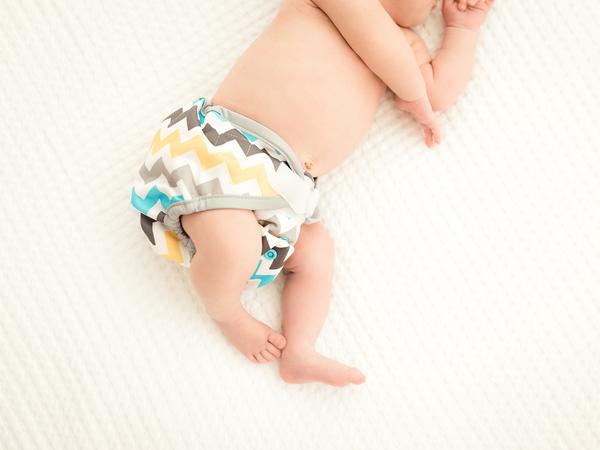
Cloth diapers and diaper-free - that contradicts itself! Or do they?
First of all, the term "diaper-free" is somewhat misleading. Other terms for it would be Elimination Communication, or EC for short. It is much more about the exchange with each other and thus about the bond and the relationship.
Diaper-free has many different facets and does not necessarily mean that a baby is not allowed to wear a diaper at all. It has nothing to do with rigid rules anyway.
You feel insecure and stressed when your baby doesn't wear a diaper at all? Maybe you're constantly worried that he might pee somewhere? Then a backup is probably right for you. A backup is a backup in case something does go wrong. Again, there are a variety of options from training underpants, a simple liner, cloth diapers, or even disposable diapers.
Cloth diapers and diaper-free go well together.
With cloth diapers, your baby gets direct feedback about its excretions through the wetness, just as it would if it were not wearing a backup. The only difference is that you don't have any wetness outside. Most babies get restless at this point at the latest and start complaining because they don't want to sit or lie in their excretions.
Another advantage of cloth diapers over disposable diapers as a backup is that they can be customized and fitted. You have a choice of materials as well as the system and thickness of the diaper.
What you prefer is up to you. Maybe you like special diapers that have a kind of belly band and are only folded back. Maybe you prefer Velcro as a closure, or even snaps. Maybe you prefer a one-piece diaper, or maybe you prefer a multi-piece system.
Many parents use only thin inserts (possibly with wetness protection), because they keep off regularly anyway and through the insert once pee or in case of doubt also poop could be caught.
I have already written above that diaper-free has many facets. Maybe it is too stressful for you to hold off at night or on the go, even then cloth diapers are super suitable as a supplement. Here, if you want, you can choose a diapering option with more absorbency.
If you have been using cloth diapers up to now, you can, for example, hold your baby over a bowl, sink or toilet when changing or after waking up, so that he or she has the opportunity to excrete. You can learn more about the simple diaper-free start in a diaper-free consultation, workshops or a special (online) course. Or even in the exchange with other diaper-free parents or through appropriate articles or books.
As you can see, cloth diapers and diaper-free do not contradict each other, they even fit together wonderfully.
Janina Pohle, the organizer of the International Diaperfree Week, interviewed Ronja Schineis-Brönner from www.diewölfin.de about cloth diapers and diaperfree. Fee talks about the advantages of cloth diapers as a backup with different systems.
Diaperfree & Breastfeeding
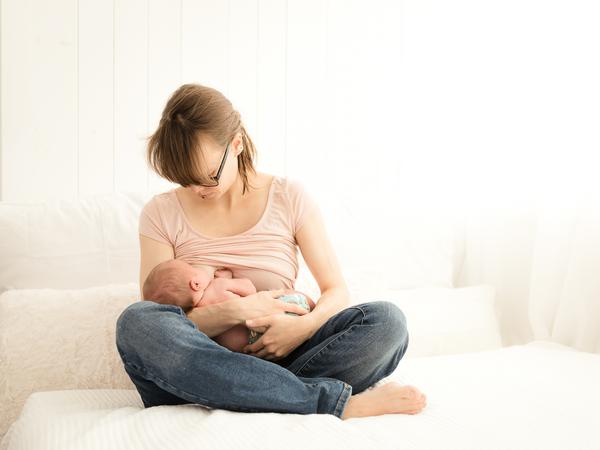
Breastfeeding is the natural feeding of an infant. Just as diaper-free is actually part of natural infant care. Nicola Schmidt, who founded the Artgerecht Project, describes both as important components of species-appropriate baby time.
Well, what comes in at the top, in this case through breastfeeding, must also come out at the bottom, probably into a bowl, the sink or the toilet when holding.
Breast milk has the optimal composition for all the needs of a baby. You can read more about the ingredients of breast milk in my article The wonderful composition of breast milk. Breast milk is easily digestible, passes through the stomach and intestines relatively quickly, and anything that is not absorbed by the body is subsequently excreted.
While the baby's bowel movements are still very regular in the first few weeks, later the stool elimination rhythm varies greatly from several times a day to once every 14 days. All this is normal in exclusively breastfed babies. The rhythm of urine excretion also changes over time as the bladder grows.
Babies often excrete while breastfeeding or right after in the early days.
Now you may be wondering how you are supposed to hold and breastfeed at the same time? You can!
If you breastfeed your baby in the cradle position, you can simply hold a small potty or bowl under his bottom so that he can eliminate while nursing. After some time, you will probably notice that your baby no longer excretes directly while breastfeeding, but with a (short) time interval afterwards. This rhythm changes every now and then over time.
When breastfeeding, you may notice that your baby docks and undocks frequently, that he is restless, cannot concentrate on sucking or tenses his belly. It probably needs to eliminate now. For this, you can simply hold it off, as described above. Other holding positions are also possible. The important thing is that you always hold your baby well and provide sufficient support.
For me, however, the priority is always first on a functioning breastfeeding relationship. If you and your baby are still unsure about breastfeeding, I would first start with diaper-free in other situations until you are really sure enough about breastfeeding to be able to hold it.
When you talk about diapering or read about it, you will probably talk about a sore bottom at some point. This can have various causes, such as infrequent diapering or allergies. In the best case scenario, your baby does not come into contact with its excrement and therefore does not get sore.
What was a bit difficult for me to put into context at first, I could now (hopefully) describe quite well. Breastfeeding and diaper-free are both parts of the natural, species-appropriate handling of babies.
Griseldis Burger from diaperfree-frankfurt.de tells Janina Pohle about the connection between breastfeeding and diaperfree. It's about elimination signals during breastfeeding, stopping breastfeeding and the question: How do I start with diaperfree?
Diaper Free & Carrying
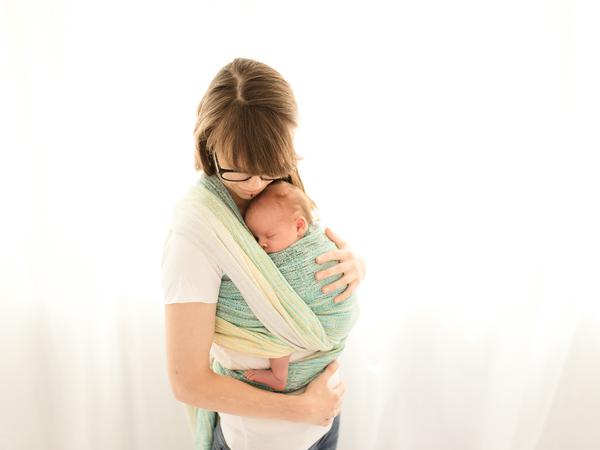
I have already described the connection between diaper-free and carrying in my article "Diaper-free carrying" with my experiences. Nevertheless, I would like to describe again the most important aspects from my point of view.
Sometimes people ask me if I don't get wet all the time when I carry my baby without a diaper in a sling or a carrier. As I already wrote in the paragraph about cloth diapers, diapers and diaper-free don't necessarily contradict each other.
But especially when wearing them, you can easily notice your baby's signals. You can tell when your baby is tightening his belly or getting restless, you can take him out of the sling or carrier and stop him. The baby has an inner need to keep himself clean as well as those around him, so he only excretes when being carried in an emergency. Babies who are not used to being held off get used to excreting in diapers and, incidentally, signal much less as a result.
In any case, if your baby fell asleep while being carried, I would hold him after he woke up. This is a standard situation that pretty much always works.
When wearing diaper-free, I would recommend choosing a carrier that allows you to take your baby out quickly and easily when he or she needs to. If your baby doesn't have a diaper on while doing this, you may want to put a cotton towel or gauze diaper between you so you don't get wet in case of doubt.
For any "accidents" I recommend easily washable materials like cotton, so you don't have to be tense about that either.
However, as always, no stress, no pressure applies to diaper-free carrying! If you are tense when your baby is not wearing a diaper in the sling, you can simply use a backup.
You may also wonder what happens when your baby is in the carrier, you go for a walk, and he or she has to pee on the way? Over time, you'll quickly learn to find suitable places to stop while you're out and about. In nature it is usually very easy, in the city it is a bit more complicated at first. But even here you will find possibilities. In case of an "emergency" I would recommend to take a gauze diaper or another absorbent cloth with you, so that your baby can excrete on it in case of doubt. In a small wetbag you can take it with you without getting your bag wet or dirty.
So diaper-free and babywearing go great together and especially when wearing it is often even easier to recognize the signals of your baby.
Janina Pohle asked Christa Birmili(mami-coach.at) about diaper-free and babywearing. She reports in the video how a baby signals while being carried and how I can easily combine diaper-free with carrying.
Diaperfree & baby sleep
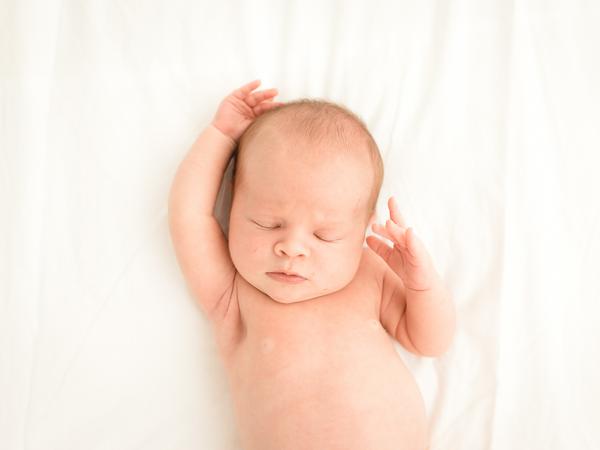
Keeping your baby off during the day When it comes to diaper-free, you might imagine. But at night? Doesn't the baby just pee in his sleep?
No, very few babies actually pee in their sleep. Just like us, babies have different sleep phases. However, the sleep phases are shorter for babies. Maybe you know the question from your environment: "And, does your baby already sleep through?", although he may only be a few weeks old. It's perfectly normal and good that babies don't "sleep through" the first few months and possibly years.
We, too, wake up at night to make sure everything is okay. Unlike our babies, we usually just go right back to sleep, so we don't even remember it the next morning.
There are several reasons why babies often wake up at night. One reason is that breast milk is digested so quickly that your baby simply needs a refill relatively quickly. Another reason is your baby's inner need for security. It makes sure that someone is around and therefore all is well. Also, a baby wakes up or gets into a very light sleep phase when it needs to eliminate.
You may have noticed that your baby gets restless in between sleeps, fidgets or tightens its legs. He probably needs to eliminate now. You can also simply hold it over a bowl at night. It is practical if your baby sleeps close to you, the bowl is within reach for holding and your baby is wearing "holding-friendly" sleepwear.
But won't my baby really wake up then? Most babies continue to sleep in a relaxed manner after being held (as long as they are not hungry or thirsty). Often, diaper-free is even easier at night than during the day because the signals are more easily understood.
But again, no pressure, no stress! You don't have to keep your baby off at night if it keeps you completely awake and you don't get enough sleep because of it. Nothing has to, everything can. Maybe you would like to try it out and find out that it is not so complicated after all.
By the way, the rhythm of excretion at night changes with the baby's age. Whereas shortly after birth the baby still has to excrete frequently at night, it becomes less frequent as time goes on. Especially in the beginning, the baby must first develop a day-night rhythm.
The fact that babies have to urinate less frequently at night than during the day - just like us, by the way - is due to hormones. This removes water from the urine and makes it more concentrated. This is why it is usually darker in the morning.
You see, also at night or generally in connection with the sleep can be held off. To do this, make it as easy and as stress-free as possible. If you find that diaper-free doesn't suit you at night and you'd rather use a diaper for that, that's perfectly fine too.
On the topic of diaper-free and baby sleep, Katarina Labudova talks about nighttime holding and elimination rhythms at night. She also has some tips for you on diaper-free at night.
Diaper-free & movement development

Maybe you know the situation when your baby is just naked and already he turns for the first time. Or sits down. Or puts his feet in his mouth. Or or or. I could think of many more examples.
And these examples show very quickly and impressively what happens when babies don't wear diapers: They unfold their full potential in terms of movement development. They are freer in their movements and are not restricted by diapers.
If you compare the movements of your baby naked with the movements of your baby in a diaper, you will notice that it moves differently.
Another point that comes to mind about diaper-free and movement development is about mobile babies who are already used to diaper-free. So when babies start to crawl or crawl, quite often the signals change as well. It may come to you or move toward the bathroom or potty when it needs to eliminate.
When the baby is finally able to sit on its own, it may no longer want to be restrained in the traditional sense, but sit on the potty itself. He may still need help getting undressed, dressed and cleaned up, but he is now much more independent. Of course, you should still not leave your baby alone.
Your baby can already sit, but would rather be held? This is also normal, babies are just like us, different and have different preferences.
If your baby wears diapers, you have probably already observed him after he has excreted. We can often tell when they have excreted by the way they move. Babies with a "full" diaper move differently, sometimes making compensatory movements to avoid soiling themselves.
If babies and toddlers have been used to diapers for a long time, these signs and signals become much less because they are unaware that their need to excrete is being recognized. Sphincter control, while already present at birth, continues to mature over the next few months and years. This is missing when babies get used to diapers.
However, that doesn't mean you necessarily have to start diaper-free at birth. There are always windows of time that work well for a diaper-free start. Any other time can also be chosen, in which case it will just probably require more patience.
Even if babies are already used to elimination communication, there can always be phases when stopping is difficult, when your baby signals little and "accidents" happen more often. Often, these periods are related to your baby's developmental milestones. When your baby is learning to turn, crawl, or walk, he or she is more engaged in this example of movement development.
If you want to learn even more about movement development in general, feel free to read my article Aspects of Child Development - Movement.
As you can see, diaper-free actually has a positive effect on your baby's movement development. Your baby doesn't have to be diaper-free all the time. Once you have become used to holding the diaper as a team, you will notice that the diaper is dry more and more often and you can simply leave it out during such phases if you don't feel stressed by it. There may always be another phase with more "accidents", but that only means that something has changed.
Janine Pohle asked Liane Emmersberger several questions on the topic of movement development and diaper-free. In particular, it is about Kinesthetic Infant Action and thus the mindful holding, which is adapted to the current developmental stage of the baby.
Diaperfree & Speech and Signing
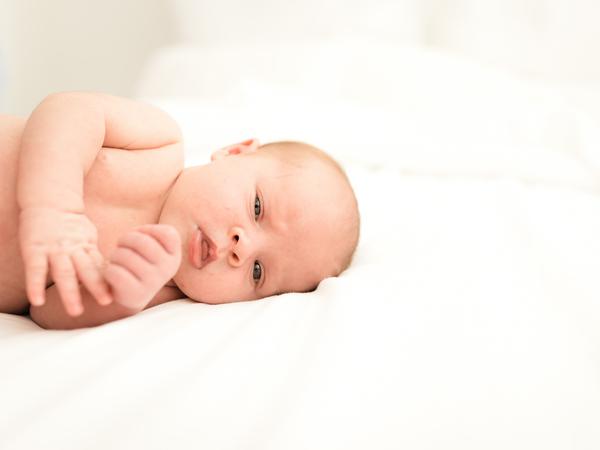
In connection with language and signing, the topic of diaper-free is probably the most difficult for me. We use very few signs even in everyday life, my daughter can't speak yet in the classical sense and with my son we started diaper-free very late. There is also relatively little information about this in the literature.
After reading the book "BabySignal" by Wiebke Gericke, I thought it would be great for Diaperfree. Signs are to be seen as a language of their own, with which babies and toddlers can express themselves and communicate much earlier than with spoken language.
If you start early with the signs, after a few months you will possibly recognize the first beginnings of your own signs in the baby. These are probably not yet so clear, simply because the hand movements are not yet as fine and coordinated as they are with us. In time, however, you will learn to recognize these movements as well, because they are different from "playing" hand movements.
There are special signs in sign language for the excretions. If necessary, you can choose the sign for toilet or actually for pee and poop and practice it with the baby. It is important to approach this without expectations. If you see it as a playful addition to your communication, without expecting your child to show the same signs the next day when he has this need, it will be stress-free for you.
Initially, almost all parents use a signal sound when eliminating so that the baby recognizes the situation and can let go more easily in the process. This sound can be "Pssss" or "Psssccchh" or even a word like "pee pee" or "poo poo".
Sometimes babies adopt these sounds as they grow, so you can tell when it's time to let go. Other babies develop their own sounds that they make whenever they need to go.
The more the baby or toddler then also says words himself, he may use the words for eliminations to draw attention to his needs.
As you can see, signing can greatly enhance and support the diaper-free method. With the signs, your child can possibly draw attention to his elimination needs much earlier, without having to signal in any other way.
So, those were the topics for this year's International Diaper Free Week, which Janina from Leonina frei & geborgen came up with. They were exciting topics and partly I really had to think a bit. I was also very happy about the videos that were shot in the course of it. Thank you very much for the input!
I hope I was able to give you some ideas and new information as well. If you have any questions or suggestions, feel free to contact me or drop me a comment.
On the topic of language and signing in relation to diaper-free, Janina Pohle again interviewed two experts. Marta Gal from purabebo.com talks about the communication at Diaperfree with sounds already in infancy. Wiebbke Gericke, the founder of babySignal, talks about the importance of signing in relation to Diaperfree.